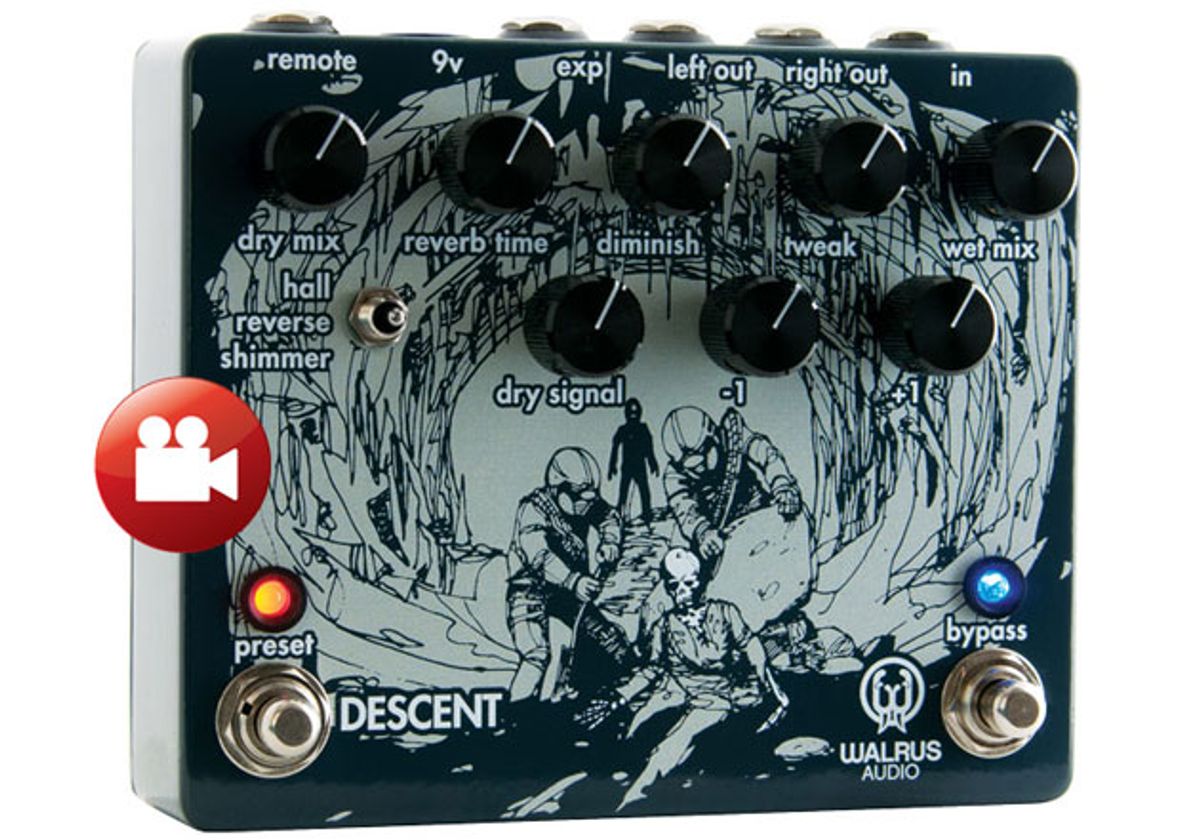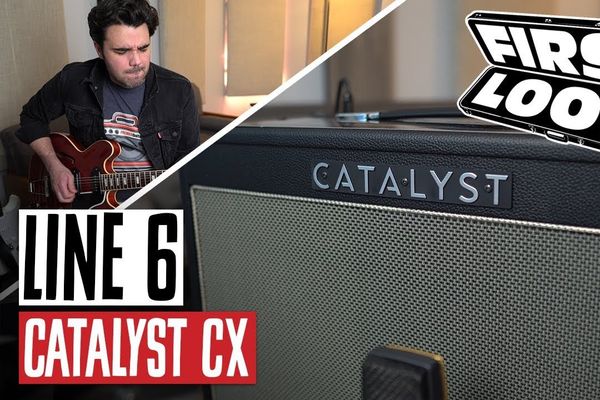Shimmering reverb and octave effects unite in what could become an essential shoegazer stompbox.
I remember how confused I was the first time I saw a cell phone with a camera—it made about as much sense as a waffle iron with a CD player. Unboxing the new Descent Reverb from Walrus Audio, which unites octave-generating effects and a modern reverb, elicited a similar sense of disorientation. History proved me wrong about camera phones, and after 15 minutes with Descent I had a similar conversion. This pedal could become a space rock/shoegazer essential.
Odd Effects United
Walrus isn’t the first company to flirt with pitch and octave-tweaked reverb. The effect has been around since the ’80s, and these days Eventide and Strymon are standard bearers for such “shimmer” effects.
But where Eventide’s Space is fairly complex and Strymon’s Blue Sky has a single shimmer-style preset, Descent splits the difference, allowing you to fine-tune the amount of shimmer in your reverb via relatively simple controls.
The reverb controls (dry mix, reverb time, diminish, tweak, wet mix) are on the top row, with the octave controls (dry signal, -1, +1) on the lower row. A mini-toggle selects from three reverb modes (hall, reverse, and shimmer). There’s no spring simulation—Descent is strictly for interstellar travelers, so look elsewhere for surf-a-billy reverb.
Ratings
Pros:
Great reverb sounds. Three footswitch-accessible user presets.
Cons:
Ambiguous control names
Tones:
Ease of Use:
Build/Design:
Value:
Street:
$price
Walrus Audio Descent Reverb
walrusaudio.com
Sonic Spelunking
Descent’s dry mix and wet mix controls work the same in all three modes. Reverb time takes you from a minimal effect to super-long, washed-out trails. In reverse mode it lengthens the trails leading up to the source note. The ambiguously named diminish and tweak controls take on varying functions, depending on the reverb type. Diminish, for instance, changes the diffusion and reflective properties of the virtual walls in hall mode, but modifies feedback in shimmer mode. Tweak controls diffusion in shimmer mode and frequency response in hall mode. While you can develop a feel for how these controls work in each mode, the ambiguity can be a liability onstage, through there’s the option of saving three user presets for quick recall.
The hall setting may get passed over as players rush to check out the more extreme stuff, but it’s one of the best I’ve heard in a pedal, clear and three-dimensional. You can make it sound really spacey as you increase the size of the room to an architecturally impossible all-marble mega-cathedral. Damping highs here with the tweak control minimizes sonic clutter.
I’m happy when a pedal brings something new to the party. Here, it’s adding octaves to reverse mode. Like any reverse reverb, the effect can mess with your timing, and the octaves can sound low-res and digital if they’re too high in the mix. But many modern players sometimes like “inorganic” effects. (I’m reminded of Jonny Greenwood’s arpeggios on “My Iron Lung.”)
The Verdict
The Descent capably fills the space between minimal reverb units and more complicated, preset-heavy devices. Walrus wins points for keeping the interface simple for an effect of this depth, though I’d still need to tape crib notes over the beautiful graphics to stay afloat onstage. If you don’t need authentic spring reverb sounds, Descent could easily be your only reverb pedal.
Watch the Review Demo:
- Walrus Unveils the Polychrome Flanger - Premier Guitar ›
- First Look: Walrus Audio Polychrome - Premier Guitar ›
- Walrus Audio Unveils the Eras - Premier Guitar ›
- Walrus Audio Introduces the Canvas Direct Box & Line Isolator - Premier Guitar ›
- Walrus Audio Eras Five-State Distortion Pedal Review - Premier Guitar ›
- Walrus Audio Eras Five-State Distortion Pedal Review - Premier Guitar ›
- Walrus Audio Unveils the Mira Optical Compressor - Premier Guitar ›
- Walrus Audio Announces Eons Five-State Fuzz - Premier Guitar ›
- Walrus Lore Guitar Pedal Review - Premier Guitar ›
- Walrus Audio Fable Granular Soundscape Generator Delay Pedal - Premier Guitar ›
- Walrus Audio Fundamental Series - Premier Guitar ›
- Walrus Audio Canvas Passive Re-Amp - Premier Guitar ›
- Walrus Audio Slöer Ambient Reverb - Premier Guitar ›
- Walrus Audio Fable Review - Premier Guitar ›
- Walrus Audio Polychrome Review - Premier Guitar ›
- Walrus Audio Introduces 385 MKII Overdrive - Premier Guitar ›
- Walrus Audio Announces Canvas Tuner - Premier Guitar ›
- Walrus Audio Announces Silt Harmonic Fuzz ›
- Walrus Audio Fundamental Ambient ›


